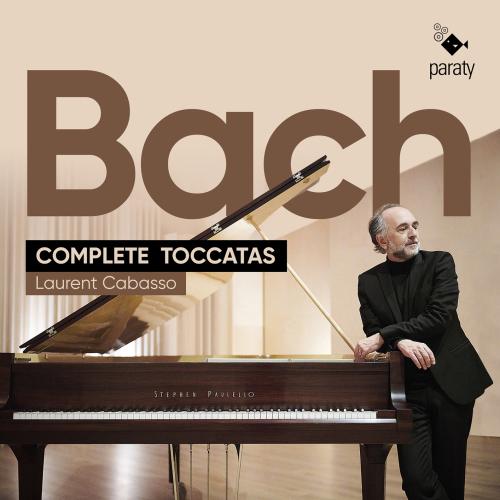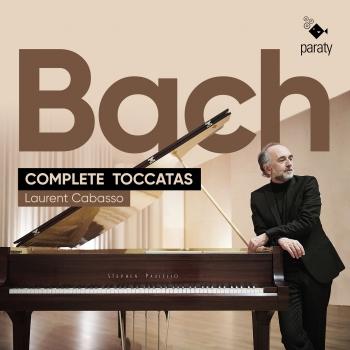
Bach: Complete Toccatas Laurent Cabasso
Album Info
Album Veröffentlichung:
2021
HRA-Veröffentlichung:
12.03.2021
Label: Paraty
Genre: Classical
Subgenre: Instrumental
Interpret: Laurent Cabasso
Komponist: Johann Sebastian Bach (1685–1750)
Das Album enthält Albumcover Booklet (PDF)
- Johann Sebastian Bach (1685 - 1750):
- 1 Toccata in G Major, BWV 916 07:15
- 2 Toccata in C Minor, BWV 911 10:44
- 3 Toccata in D Minor, BWV 913 12:39
- 4 Toccata in E Minor, BWV 914 07:21
- 5 Toccata in F-Sharp Minor, BWV 910 10:47
- 6 Toccata in G Minor, BWV 915 08:18
- 7 Toccata in D Major, BWV 912 10:33
Info zu Bach: Complete Toccatas
Johann Sebastian Bach’s first instrument was the violin. He studied it with his father, a violinist and violist, who in so doing introduced him to music. The harpsichord came next, then the organ. At eighteen years of age, he had mastered these instruments to perfection, and he composed. For the harpsichord and organ at first, which enabled him to express his polyphonic thinking. The orchestra and the other instruments would follow, with voices.
And yet first and foremost, when he was barely out of his teens, it was the contact with the master Buxtehude – as well as with the music of Northern German composers – that would catalyse his creative fervour. This encounter was decisive for the rest of his days, and seems to have liberated in him an intoxication with imagination and with instrumental virtuosity. How old was he, then, when he wrote his seven toccatas for keyboard that we know of? We don’t know. Perhaps barely older than twenty. He was a very young man, impetuous, curious about all the music that was then being made. His position at Arnstadt required him to prelude the chorales on the organ, which he did according to the models left behind by Pachelbel, which he studied alongside his elder brother in Ohrdruf. But his own personality, how could he best express it in all of its diversity?
It was the toccata which would allow him to do so, which he intended for his own delight or for his first
students. The toccata is not a form; it is actually the freest of musical genres, since it is written without the slightest apparent constraint, without a predetermined schema to respect – or to transgress. It is up to the composer to create his own form. And in the course of these seven toccatas, one will see and hear the young genius seeking form through trial and error. He would try his hand at the prelude and fugue, the improvised fantasia, the great fresco in multiple episodes, and the concerto genre.
Laurent Cabasso, piano
Laurent Cabasso
studied at the Conservatoire National Supérieur de Musique de Paris (with Yvonne Loriod, Jean Hubeau and Christian Ivaldi) where he obtained First Prizes in Piano and Chamber Music, the year he turned eighteen. He then went on to advanced studies with Nikita Magaloff, György Sebok, György Sandor and Norbert Braïnin. He also studied with Désiré N’Kaoua, and later in London with the famous piano teacher Maria Curcio-Diamand, who was an Arthur Schnabel’s disciple.
After winning prizes at several international competitions (Geza Anda Prize in Zurich in 1982, Tokyo in 1983, finalist at the Clara Haskil Competition in Vevey in 1987), he embarked on a major international career. He gives regular recitals and concerts in such centres as Paris (Théâtre des Champs-Élysées, Salle Pleyel, Philharmonie), Zurich (Tonhalle), Amsterdam (Concertgebouw), Geneva (Victoria Hall) and Salzburg (Festspielhaus), and appears at festivals like La Roque d’Anthéron, Piano aux Jacobins, la Folle journée de Nantes, Besançon, and Montpellier, as well as in America and Asia. He also takes part in concerts as soloist with orchestras including the Suisse Romande, Monte-Carlo, Zurich, Capitole de Toulouse, Ensemble Orchestral de Paris, Lausanne Chamber Orchestra, Orchestre National de Lyon, Orchestre National de France and the Orchestre National de Lille with conductors such as Charles Dutoit, Ferdinand Leitner, Serge Baudo, Armin Jordan, Tibor Varga, Jean-Claude Casadesus, Emmanuel Krivine, Michel Plasson….
Booklet für Bach: Complete Toccatas










